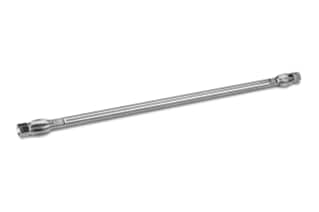
|
Chemistry |
Phenyl |
|
Separation Mode |
Reversed Phase |
|
Particle Substrate |
Hybrid |
|
pH Range Min |
1 pH |
|
pH Range Max |
12 pH |
|
Maximum Pressure |
6000 psi (415 Bar) |
|
Endcapped |
Yes |
|
Bonding Technology |
2-methyl-2-phenylethyl |
|
Silanol Activity |
Low |
|
Particle Shape |
Spherical |
|
Particle Size |
5 µm |
|
Endfitting Type |
Waters |
|
Pore Size |
125 Å |
|
Format |
Column |
|
Surface Area |
175 |
|
System |
HPLC |
|
USP Classification |
L11 |
|
Inner Diameter |
4.6 mm |
|
Length |
250 mm |
|
Carbon Load |
12 % |
|
UNSPSC |
41115709 |
|
Brand |
XTerra |
|
Product Type |
Columns |
|
Units per Package |
1 pk |

XTerra 2-methyl-2-phenylethyl Column, 125Å, 5 µm, 4.6 mm X 250 mm, 1/pk
Add the XTerra 2-methyl-2-phenylethyl Column to your lab equipment collection as it is a hybrid-based, reversed-phase column that incorporates phenyl ligand functionality. These first-generation Xterra columns provide superior pH stability when compared to a silica-based column.
The XTerra 2-methyl-2-phenylethyl Column is a crucial piece of lab equipment that can provide complementary selectivity compared to straight-chain alkyl stationary phases, especially for compounds with aromatic rings. It also delivers high pH stability, optimal surface coverage as well as excellent peak shape for all compounds and highly reproducible retention times. This is possible as it leverages the powerful combination of Hybrid Particle Technology and the Xterra phenyl chemistry, which results in a unique stationary phase, which is able to offer these outstanding features. In addition to this, the difunctional bonding chemistry of the short-chain phenyl ligand in the XTerra 2-methyl-2-phenylethyl Column imparts improved low pH hydrolytic stability to the column. This unique substrate and ligand add a new dimension in selectivity for separations of complex mixtures.
The packing materials used in the XTerra 2-methyl-2-phenylethyl Column are synthesized using Waters Hybrid Particle Technology. The XTerra particles contain both inorganic (silica) and organic (organosiloxane) components sharing the advantages of both. This Hybrid technology makes the high efficiency of separation and improved pH stability possible, when compared to Silica-based reversed-phase packing materials. The manufacture of XTerra Columns is done using only ultrapure reagents to control the chemical composition and purity of the Hybrid particle. Every manufacturing step is conducted within narrow tolerances and each column is individually tested. Certificates of Batch Analysis and Column Efficiency are provided with each column.
The Xterra Columns are available in a variety of pore and particle sizes to meet your different chromatographic needs. You can learn more about them in our catalog or through our website and also shop for lab equipment using either of the mediums.
Waters recommends the use of the XTerra 2-methyl-2-phenylethyl VanGuard Cartridge, 125Å, 5 µm, 3.9 mm X 5 mm, 3/pk with the XTerra 2-methyl-2-phenylethyl Column to help protect the analytical column from harm such as chemical and particulate matter that enters the mobile phase.
What Does A Phenyl Group Look Like?
A Phenyl group has a cluster of six carbon atoms bonded together in a hexagonal planar ring, five of which are bonded to individual hydrogen atoms, with the remaining carbon bonded to a substituent. Phenyl groups are commonplace in organic chemistry.